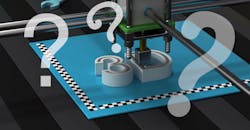3D Printing: What is it Good For?
3D printing, also known as additive manufacturing (AM), could be a game-changer for manufacturing, enabling significant savings of cost, time, and materials. In traditional manufacturing, parts are made in large quantities at centralized factories, then shipped to consumers. But with the growth of 3D printing, many wonder if technology will cause a shift from this centralized model to a more distributed model, in which facilities in different locations coordinate to fill manufacturing needs.
A team of researchers from Carnegie Mellon University’s Engineering and Public Policy Dept. (EPP) and the University of Lisbon investigated how 3D printing could contribute to distributed manufacturing. They examined whether 3D printing will disrupt this central model, specifically in the context of spare parts for the aerospace industry, where being able to quickly print parts instead of stockpiling them would be attractive.
“Our results suggest that 3D printing may not be as conducive to distributed manufacturing as some might hope,” says Parth Vaishnav, a research professor in EPP. He and his team believe 3D printing is more suitable for non-critical parts that do not need to be expensively processed after emerging from the printers.
The team points out that the discussion around 3D printing’s potential for changing manufacturing practices has been exaggerated in some contexts, especially if one considers its economics. In manufacturing, a company chooses whether to site factories nearer or farther from their markets and customers, which affects shipping and stockpiling costs. Although decentralized 3D printing close to where products are needed may reduce the need to carry inventory, the expensive machines sometimes needed to process parts after being 3D printed may still favor centralized manufacturing.
To figure out how several influences might shape 3D printing in manufacturing, the researchers used cost and location models to estimate supply-chain costs in aviation, an industry that already 3D prints some parts. The team found that conventional, centralized manufacturing would likely remain more cost-effective when compared to distributed manufacturing. Decentralized manufacturing would only become attractive if production volumes increased or the need for post-processing parts decreased.
The researchers chose to focus on non-critical spare parts because the Federal Aviation Administration, which ensures the safety of the U.S. air system, only requires that such parts be equivalent to existing ones and meet necessary safety requirements. A crucial assumption in the analysis is that many different types of parts could be printed on a single 3D printing machine.
The team concluded that decentralizing manufacturing would make economic sense for non-critical spare parts with combined annual production volumes in the tens of thousands.
The model also suggests that this reasoning is unlikely to change even if 3D printers become much less expensive or faster. If 3D printers improved enough that post processing could be eliminated, however, then decentralized manufacturing would be economical at lower volumes (tens of thousands). Less expensive machines would also mean labor will become a larger proportion of total costs. This could be mitigated by automating the machines, which in turn could affect employment.
Additive manufacturing has enormous potential for good, and the researchers encourage companies and policymakers to take it seriously. They should, however, not assume that it goes hand-in-hand with distributed manufacturing.

